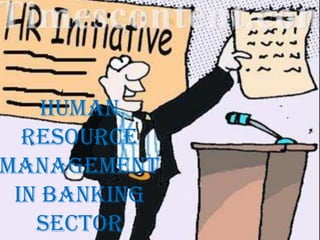Hrm in banking group 1
- 1. HUMAN RESOURCE MANAGEMENT IN BANKING SECTOR
- 2. ROLE OF HR IN BANKING ï Applicant Screening ï Development ï Bank Security ï Pay Decisions ï Executive Recruitment ï Communication
- 3. ïSystems/ Processes ï Staff Meetings ï Brain Storming Sessions ï Study Circle ï Quality Circle
- 4. CHALLENGES FACED BY THE BANKS: 1.The real challenge of this sector is the "Indian companies", how to transform into global corporations without losing the positive values and culture that they have developed. 2.As most part of the jobs in this industry is monotonous/repetitive and routine, the HRD Department has to empower, engage and energies employees to create effectiveness & efficiency through motivation organizational structures, systems & procedures are facilitators of these, and there is a need to focus greater attention on these aspects by the industry. 3.However, the emergence of a core and peripheral workforce in many organization has presented new challenges for HR managers public & private sector organizations are fast becoming diverse communities for core workers, flexibly employed casual and part-time workers, consultants, contractors & business partners. 4.Certain rigidities have also developed in HRD within this banking system itself because this industry is largely in the public sector.
- 5. HR PRACTICES IN ICICI BANK Sources of recruitment: âĒAdvertisements â newspapers , magazines âĒCampus Recruitment âĒHead Hunters- executive search âĒJob portals âĒConsultancies or agencies âĒEmployee Referral âĒWalk in Selection process: âĒAptitude test âĒGroup Discussion âĒPsychometric Test âĒInterview
- 6. ïSavvy HR saves ICICI Bank Rs 100 crores ïICICI Group has successfully implemented Sum Total's solution as an enterprise application for aligning the e-Learning needs of its employees. ïICICI Group includes companies like - ICICI Bank Ltd. ICICI Prudential Life Insurance Co., ICICI Lombard General Insurance Company and ICICI Securities LTD. ïSum Total Systems deployed its award-winning Sum Total Enterprise Suite(TM) in the bank's Learning Management System called "The Learning Matrix.â ïThis implementation has provided ICICI an efficient and cost- effective business learning management solution making training more accessible to employees.
- 7. HR PRACTICES IN AXIS BANK âĒ Initiate & institutionalize globally competitive HR practices. âĒ Create a performance-driven culture and an exciting workplace. âĒ Create a pool of entrepreneurial managers and business leaders. âĒ Create a learning organization for employees.
- 8. FUNCTIONS OF HRD âĒ Ultimate aim of the human resources function is to build and manage a motivated pool of professionals delivering optimum value to customers. âĒ Major platforms on which the success of the bank's corporate strategy rests is bringing on board the requisite skills. âĒ Young bank with an average age of 29 years and a talent pool comprising a mix of new recruits and experienced officers. âĒ Training-Scheduling. Performance Management. Compensation/Reward Administration. Grievance Handling.
- 9. HR PRACTICES IN BANK OF BARODA âĒ A very strong Organizational Leadership at different levels forms the key link in the Model âĒ People oriented Deployment, Promotion and selection policies âĒ Talent identification and grooming programmes
- 10. Customized Leadership development programmes âĒ PROJECT LEAP âĒ PROJECT UDAAN
- 11. HR PRACTICES IN ANDHRA BANK ïSkill Improvement Trainings ïBasic level Orientation Programmes. ïEntrepreneurial Development Programmes ( EDPs )
- 12. CONCLUSION ïHR functions to be linked to corporate goals. Shift from Industrial relations manager to Business manager or Commercial manager. ïTeam work is another important and essential soft skill that is necessary in this industry. ïThe HR Professionals have to introduce &improve the adaptability of their structure that will be able to absorb, draw and retain the best. ïAs people are primary asset, it is essential not only to invest in them, but also to ensure that the supporting elements for this asset are such that it can provide the maximum value on a sustainable basis. ïHRD is to be regularly reviewed against business outcomes as part of strategic and operational planning. ïTo overcome the public sector's hierarchical structure, which gives preference to seniority over performance, is not the best environment to attract the best talent from among the young.
- 13. By, Abhisekh Gupta -1 Biswajita Mohanty - 13 M Naga Raju - 39 Nidhi Maheshwari - 50 Prasun Chandra - 57 Shashi Shekhar Sharma - 79 Vikas Kalani - 99













